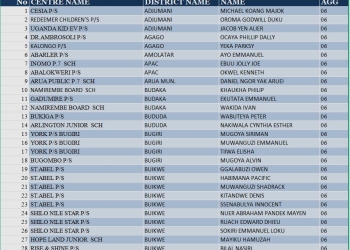 As part of the government of Uganda’s efforts to contribute to the global 2030 Agenda of ending AIDS, Naguru Teenage Centre (NTC) is implementing a groundbreaking project to empower Adolescent Girls and Young Women (AGYW). This initiative focuses on reducing new HIV infections in Kampala, Wakiso, Mukono, Namayingo, and Kamuli districts. It entails targeted interventions that promote awareness, access to services, and meaningful youth engagement.
As part of the government of Uganda’s efforts to contribute to the global 2030 Agenda of ending AIDS, Naguru Teenage Centre (NTC) is implementing a groundbreaking project to empower Adolescent Girls and Young Women (AGYW). This initiative focuses on reducing new HIV infections in Kampala, Wakiso, Mukono, Namayingo, and Kamuli districts. It entails targeted interventions that promote awareness, access to services, and meaningful youth engagement.
Funded by the United Nations Children’s Fund (UNICEF) Uganda, the project primarily targets AGYW aged 10–24, with secondary support from adolescent boys, peer mothers, health workers, and youth leaders. Key stakeholders such as government agencies and opinion leaders form the tertiary target, as boosters to promoting policy support and an enabling environment.
Linda Tulina, a Behavioral Change Communication (BCC) Officer at NTC, revealed that this nine-month project seeks to leverage a multi-sectoral approach that integrates HIV prevention, Sexual and Reproductive Health and Rights (SRHR), and support for Gender-based violence (GBV).
“This project directly tackles these issues by enhancing coordination and building capacity at national and sub-national levels,” she revealed, during a recent district entry meeting in Kamuli district.
Similarly, Silas Isabirye, a Monitoring and Evaluation (M & E) Officer at NTC, noted that the project targets over 679,000 individuals, with activities such as training healthcare workers and offering vocational skills to vulnerable AGYW. Key components of the project include conducting outreach programs in schools and communities, empowering youth leaders to advocate for health services, and utilizing innovative telehealth platforms to disseminate critical information on HIV, SRHR, and GBV prevention.
It should be noted that the AGYW, particularly those aged 15–24 years, remain disproportionately affected by the HIV epidemic. According to the Uganda Population-based HIV Impact Assessment 2020/21 report, this age group has the highest HIV incidence rate at 0.62% compared to all other age groups in Uganda.
Regionally, AGYW represent a significant share of new infections, accounting for 68% of young people living with HIV in Eastern and Southern Africa (ESA).

“This alarming situation highlights the urgent need for targeted interventions that provide AGYW with the necessary education and health services to support their sexual and reproductive health while enabling them to continue their education.” Dr Barbara Asire, UNICEF Representative, revealed.
National Response Driven by Ministries of Health, Education, and Gender
Uganda is a signatory to a nine-year global initiative to end AIDS, led by UNICEF and UNAIDS, which emphasizes a multi-sectoral approach engaging communities, the private sector, and other key players.
“While we’ve made progress, we still fall short of global targets. Over 60% of our key populations, including pregnant women, are adolescent girls and young women, and they must remain at the center of our response,” Dr Faridah Akuju, a program officer at the Ministry of Health, revealed.
She added that alarmingly, AGYW account for 79% of new HIV infections among adolescents and young people. Meanwhile, condom use remains low, at 33.2% for females and 41.8% for males, while HIV testing uptake among people living with HIV aged 15–24 is 63.7% for females and only 47.3% for males.
Adding, “Access to treatment also shows gaps. Among those aware of their status, only 60.7% of females and 47.3% of males are on ART. Viral load suppression is critically low, just 52.39% for females and 37.6% for males.”
Nanga Allen Claire, a Ministry of Education and Sports (MoES) representative, highlighted ongoing efforts to address teenage pregnancy in schools.
“We developed guidelines for managing teenage pregnancy in schools, including a component on re-entry for affected learners. We also created guidelines for forming school clubs. However, some of these clubs are phasing out,” she revealed.
She added that the Ministry of Education and Sports (MoES) has developed reporting and tracking guidelines to guide young people on where and how to seek help. “We piloted a support system in Luwuka and Butaleja districts, linking schools to nearby health facilities and assigning/ a focal person. This approach acknowledges that many adolescent girls and young women do not visit health facilities when they need support.”
Pimer Sylvia, Youth Officer at the Ministry of Gender, Labour and Social Development, emphasized the need to strengthen Behavior Change Communication (BCC) with a focus on strategic messaging aimed at reducing teenage pregnancy, child marriage, and new HIV infections among adolescents.
She also highlighted the importance of aligning this project with the National Strategy to End Teenage / Pregnancy, which clearly outlines the roles of all stakeholders. She said,
“As part of this, the project will incorporate and promote the use of Parenting Guidelines and Standards, recognizing that improved parenting is key to guiding and protecting adolescents. These materials will be disseminated and implemented more effectively under this project.” We also need to raise more awareness about Sauti 116, a toll-free child helpline, so that more young people can access the support they need.”
Local Leaders Step Up to Champion AGYW Empowerment.
Badru Sentongo, the Deputy Chief Administrative Officer for the Kamuli district, raised concerns about the high rates of teenage pregnancy in Kamuli and Namayingo, urging a shift in strategy when current approaches fail to deliver results. He expressed frustration with the top-down model and stressed the importance of involving local leaders and communities in designing solutions.
“Ideas should originate from the local leaders who know their problems better than anyone else. We must adopt a holistic approach where both the girl-child and boy-child are equally engaged,” he said.
John Batani, Senior Nursing Officer in Kamuli District, commended NTC and UNICEF for their support. “NTC, through UNICEF, has been instrumental in providing health education and skilling for both boys and AGYW, which has helped reduce teenage pregnancy in our district,” he said.
Batambuze John Robert, RDC Kamuli, pledged full support to the implementing partners. “With many idle young women and girls in Kamuli, this support is a great privilege. We shall offer airtime, especially on Sebo FM at 7 PM, to raise awareness and mobilize the community.”
Kwesiga Eva, Resident District Commissioner of Namayingo district, said, “We hope that through this project, we will reduce poverty levels, as skills training is one of our government’s key priorities.”
Oundo Humphrey Makoha, Namayingo District Inspector of Schools, emphasized, “While our goal is to strengthen essential health services, many of the factors impacting health outcomes are deeply rooted in communities. We urge the justice, law, and order sectors to collaborate with us in promoting rights-based approaches at the grassroots level.”

















